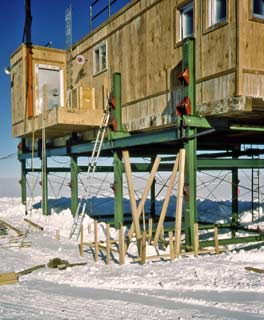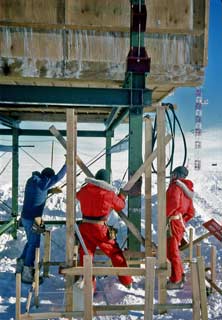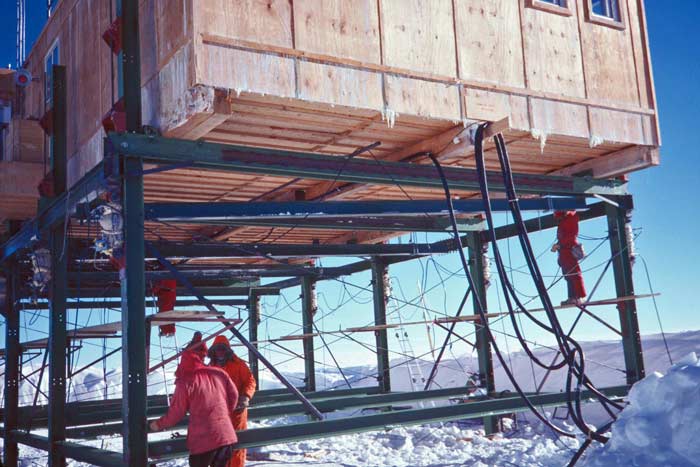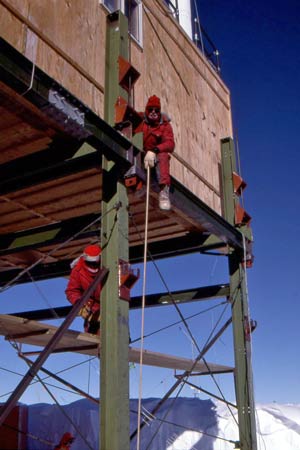Jacking the Clean Air Facility
|
Everything at Pole tends to get buried eventually. There are only 2 ways to avoid this with buildings that aren't buried to begin with...tow them up out of their hole onto a new elevated snow pad as was done with the elevated dorm/IceCube laboratory a few years ago...or jack them up in place. This structure, amazingly, was stick-built in one summer season (my first, in 1976-77)...I didn't believe that this project could be completed in one summer, and I was amazingly impressed that H&N construction superintendent Pat Haggerty was able to pull it off. Before we went to the ice that season, engineer Frank Brier, who'd been involved in its original design, showed up briefly in the Anaheim office to look over the design and offer construction advice. I asked him how it was supposed to be jacked up...his response was that it had been designed to be jacked up, but that the actual jacking methods hadn't been part of the design. Little did I know that I'd again become part of the program when that operation became necessary. Actually, as I had only been hired by ITT/ANS in September 1986, I had been totally uninvolved with the planning for this operation...that had been tasked to my ITT coworker engineer, the late Brian Smith. The previous season, a simpler cheaper operation with mechanical jacks had been attempted, but it wasn't successful. This time he did well. A scheme using manifolded hydraulic jacks was used...a vendor representative put the package together and came down to Pole to conduct the jacking operation. Some of the structure including the column extensions had been added the previous season...other parts of it including some of the jacking beams and the red brackets (and threaded rod which supported the structure when the jacks were adjusted) were part of this project. All of this was in place when I showed up on 24 December 1986, and the jacking operation was soon underway and completed. Then the stairway had to be reconstructed...  Here's a "before" photo. Inside the small heated module at left was the control manifold along with a hydraulic fluid reservoir. There were hoses connected to each jack. What would happen for each lift--first, all of the jacks would slowly be extended to their maximum lift, then they'd be equalized at the same elevation based on the manifold pressure gauges for each jack. Then, after locking in the pressures, the nuts on the threaded rods would be tightened to support the structure. The hydraulic pressure on the jacks would then be relieved, and they would be removed so that their brackets could be raised and positioned for the next lift (WR). | |
 Although access to the building was a bit difficult while this was going on, NOAA operations continued uninterrupted. |
 Here are some of the carpenters working on laying out and building the stairway. The original design (maintained here for the present) was that the back/upwind door was an emergency exit with a ladder (which obviously didn't meet current safety standards). |
|
This stairway would be replaced a year later with an aluminum stairway; the project included a stairway to the roof and a platform that wrapped around the building to the rear exit. The other thing which is obvious from these photos..the white streaking and bits of ice on the exterior walls--signs of moisture. The structure was constructed using state-of-the-art mid-1970's technology...basically plywood walls with perhaps 12" of fiberglass insulation and a vapor barrier. But with all of the conduit and instrumentation penetrations in the floor, walls, and roof, eventually there was lots of ice frozen into the fiberglass...as I found out a couple of years later when I accompanied CRREL engineer Wayne Tobiasson; we took core samples through the roof and found lots of ice. All of the photos on this page are mine except for the ones marked WR...which is Wayne Ranney, a geologist who was working at Pole in December and January 1986-87. Here's his hero shot in front of the jack manifold module (WR). They are from this page on his Earthly Musings blog. | |


